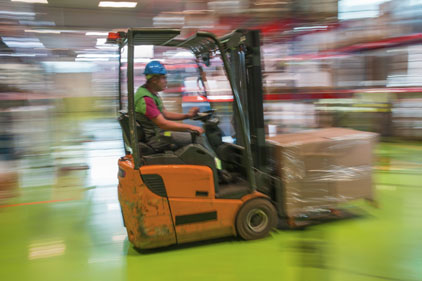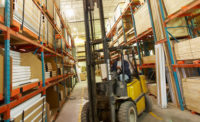This article outlines a few important aspects of forklift safety: operator training, equipment safety and workplace awareness.
Training is top priority
Comprehensive training for all forklift operators is imperative. OSHA requires all powered industrial truck operators to be trained and certified by their organizations. Employers must develop and implement a training program based on the general principles of safe truck operation, the types of vehicle(s) being used in the workplace, the hazards of the workplace created by the use of the vehicle(s), and general safety requirements of the OSHA standard. Trained operators must know how to do the job properly and do it safely as demonstrated by workplace evaluation. Employers must provide formal (lecture, video, etc.) and practical (demonstration and practical exercises) training.
Employers must also certify that each operator has received training and evaluate each operator at least once every three years. Prior to operating the truck in the workplace, the employer must evaluate the operator’s performance and determine the operator to be competent to operate a powered industrial truck safely.
The OSHA standard provides a list of training topics that must be covered; however, the employer may exclude those topics which are not relevant to safe operation at the employee’s work location. Training must be conducted by a qualified trainer.
A “Forklift Safety Guide” from the state of Washington’s Department of Labor and Industries, Division of Occupational Safety and Health (DOSH) outlines the following operator procedures that reduce the risk of overturn, collision or loss of the load:
- Make sure the load is stable and safely arranged on the forks.
- Do not tilt the forks forward except when picking up or depositing a load.
- Tilt the load backward only enough to stabilize the load.
- Keep the load low just above the pavement with forks tilted back when traveling.
- Cross railroad tracks diagonally when possible.
- Enter elevators squarely.
- Keep the load uphill when going up or down an incline.
- Drive at a speed that will allow you to stop safely within the stability triangle.
- Slow down on wet or slippery surfaces.
- Slow down to make turns.
- Avoid driving over loose objects or on surfaces with ruts and holes
Know your equipment
There are many types of powered industrial trucks. Each type presents different operating hazards. For example, OSHA says a sit-down, counterbalanced high-lift rider truck is more likely than a motorized hand truck to be involved in a falling load accident because the sit-down rider truck can lift a load much higher than a hand truck.
OSHA requires operators to be trained in the following truck-related topics:
- Operating instructions, warnings and precautions for the types of truck the operator will be authorized to operate.
- Differences between the truck and the automobile.
- Truck controls and instrumentation: where they are located, what they do and how they work.
- Engine or motor operation.
- Steering and maneuvering.
- Visibility (including restrictions due to loading).
- Fork and attachment adaptation, operation and use limitations.
- Vehicle capacity.
- Vehicle stability.
- Any vehicle inspection and maintenance the operator will be required to perform.
- Refueling and/or charging and recharging of batteries.
- Operating limitations.
Optimal safety also requires that the forklift itself be working properly. The Washington DOSH guide offers this pre-use inspection checklist:
- Is the horn working? Sound the horn at intersections and wherever vision is obstructed.
- Are there hydraulic leaks in the mast or elsewhere? These could cause slipping hazards or lead to hydraulic failure.
- Are fuel connections tight and battery terminals covered? Dropping a piece of metal across battery terminals can cause an explosion.
- Is there a lot of lint, grease, oil or other material on the forklift that could catch on fire?
- Do sparks or flames come out from the exhaust system?
- Does the engine show signs of overheating?
- Are tires at proper pressure and free of damage? A tire with low pressure or a tire failure can cause a forklift to tip or fall when a load is high.
- Do all controls such as lift, lower and tilt work smoothly? Are they labeled?
- Is there any deformation or cracks in the forks, mast, overhead guard or backrest?
- Are lights operating if used at night or in dark locations?
- Is steering responsive? A lot of play or hard steering will reduce control.
- Do brakes stop smoothly and reliably? Sudden stops can cause tipping.
- Does the parking brake hold the forklift on an incline?
- Are seat belts (if equipped) working and accessible?
- Is the load capacity plate readable?
Any defects that would affect safety must be corrected before the forklift is returned to service.
Workplace awareness
Workplace type and conditions are also factors in hazards commonly associated with powered industrial trucks, OSHA says. For example, retail establishments often face greater challenges than other worksites in maintaining pedestrian safety. Beyond that, many workers can also be injured when 1) lift trucks are inadvertently driven off loading docks; 2) lifts fall between docks and an unsecured trailer; 3) they are struck by a lift truck; or 4) they fall while on elevated pallets and tines.
The surface a forklift operates on can also pose serious safety problems, according to the DOSH guide. Loose objects, bumps, or depressions can cause loss of steering control, a sudden unplanned stop or a dropped load. A soft dirt surface can cause a wheel to sink and destabilize an elevated load and the forklift.
Any surface a forklift drives on must be able to support the forklift and its load with a safety factor of four. If a 7,000 pound forklift is carrying a 3,000 pound load then the floor must be able to support 40,000 pounds, DOSH says. Remember that nearly the full weight of the load plus a part of the weight of the forklift may be centered near a single wheel.
Wet, oily or icy surfaces should be avoided. Clean them up as soon as possible.
Resources
For more comprehensive information on forklift safety, view the Washington State DOSH “Forklift Safety Guide” at www.lni.wa.gov/IPUB/417-031-000.pdf; OSHA’s Powered Industrial Trucks (Forklift) eTool at www.osha.gov/SLTC/etools/pit/index.html and OSHA’s Powered Industrial Truck topic and training pages at www.osha.gov/SLTC/poweredindustrialtrucks/index.html and www.osha.gov/dte/library/materials_library.html#poweredindustrialtrucks.







